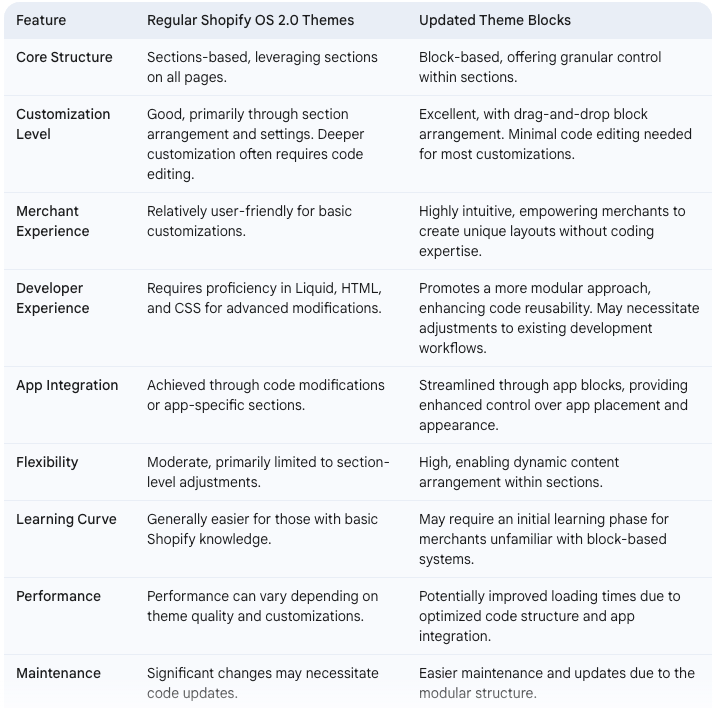1. What is a Theme Block
Theme blocks are blocks that are defined at the theme level. You can reuse theme blocks across different sections of the theme, unlike section-defined blocks that can only be used within the section where they're defined. Additionally, theme blocks can be nested within other theme blocks to create a hierarchy. Follow some Theme block features for more details:
Metafields Integration within Blocks: Directly connect metafields to blocks, allowing for dynamic content population. This is incredibly powerful for displaying custom product information, collection details, or page-specific data without extensive coding.
Enhanced App Block Capabilities: Improved API and developer tools for creating more robust and interactive app blocks. This leads to richer integrations and more seamless experiences for merchants using apps within their themes.
Improved Block Settings and Controls: More granular control over block settings, including advanced styling options, conditional logic for displaying elements, and better handling of responsive design.
Performance Optimizations: Updates to the block rendering engine have resulted in faster loading times and improved overall theme performance. This is crucial for providing a smooth and responsive shopping experience.
Increased Flexibility for Developers: Refined APIs and Liquid features that make it easier for developers to create complex and dynamic blocks. This empowers developers to build more innovative and feature-rich themes.
More Robust and reliable block rendering: Shopify has worked hard to make the block rendering more reliable, so that there are fewer errors when users are customizing their store.
Better handling of complex layouts: The updated theme blocks, handle complex layouts better, so that the store owners can create more unique and interesting designs.
Better code reusability: Shopify has made it easier for developers to reuse code, when making blocks, this speeds up development time, and makes themes more efficient
Theme Blocks essentially give merchants powerful yet controlled ways to customize their online store's appearance and functionality without deep technical knowledge.
Follow this link to learn more about Theme Blocks
2. Key differences between regular Shopify OS 2.0 themes and those utilizing updated theme blocks
You can find a detailed overview of the key differences in the comparison table below.

For a clearer understanding of the difference, let's explore the structural variations of a Slideshow section built with regular Shopify OS 2.0 versus Theme Blocks, as demonstrated below:
Slideshow section built with Shopify OS 2.0 Theme:
Slideshow section built with Shopify Theme Blocks:
2.1. Core Structure
Shopify OS 2.0: Sections-based, some flexibility with sections on all pages.
Theme Blocks: Block-based, granular control within sections.
2.2. Customization Level
Shopify OS 2.0: Good, primarily through section arrangement and settings. Some code editing required for deeper customization.
Theme Blocks: Excellent, drag-and-drop block arrangement, minimal code editing needed for most changes.
2.3. Merchant Experience
Shopify OS 2.0: Relatively easy to use for basic customizations.
Theme Blocks: Very intuitive, empowers merchants to create unique layouts without coding.
2.4. Developer Experience
Shopify OS 2.0: Requires familiarity with Liquid, HTML, CSS for advanced customizations.
Theme Blocks: More modular, promotes code reusability, but may require adjustments to existing development workflows.
2.5. App Integration
Shopify OS 2.0: Possible through code edits or app-specific sections.
Theme Blocks: Seamless app integration via app blocks, better control over app placement and appearance.
2.6. Flexibility
Shopify OS 2.0: Moderate, limited to section-level changes.
Theme Blocks: High, allows for dynamic content arrangement within sections.
2.7. JSON Templates
Shopify OS 2.0: Uses JSON templates
Theme Blocks: Uses JSON templates
2.8. Metafields
Shopify OS 2.0: Enhanced support for metafeilds
Theme Blocks: Enhanced support for metafeilds
2.9. Learning Curve
Shopify OS 2.0: Easier for those with basic Shopify knowledge.
Theme Blocks: May require some initial adjustment for merchants unfamiliar with block-based systems.
2.10. Performance
Shopify OS 2.0: Can vary depending on theme quality and customization.
Theme Blocks: Potentially faster loading times due to optimized code structure and app integration.
2.11. Maintenance
Shopify OS 2.0: Requires code updates for significant changes.
Theme Blocks: Easier to maintain and update due to modular structure.







